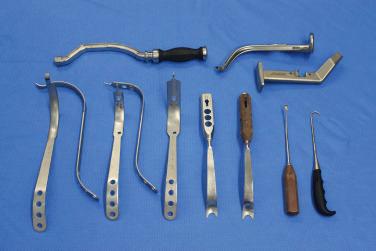Physical Address
304 North Cardinal St.
Dorchester Center, MA 02124
The direct anterior approach (DAA) provides a safe approach to the hip joint with the advantages of using both an internerve and intermuscular plane and avoiding abductor muscle disruption. It allows for early patient mobilization and fast recovery. The approach can be extended both proximally and distally using special techniques.
Using the supine position on a conventional table allows for a faster and less complicated operating room setup.
The DAA without a special table allows for intraoperative evaluation of hip stability and accurate leg length measurements.
Positioning the pelvis supine on a conventional table allows for easier and more accurate acetabular orientation.
A careful and stepwise method must be performed with a DAA to ensure adequate exposure.
Acetabular and femoral exposures are essential to adequate component position.
No special operating room table is needed, but fluoroscopy is still possible based on surgeon preference.
Total hip arthroplasty (THA) using the direct anterior approach (DAA) has increased in popularity over the past decade. As with all other approaches to the hip, the DAA provides safe access to the hip joint but with the added advantages of being both interneural and intermuscular without abductor muscle disruption. Being an anterior approach to the hip, hip dislocation precautions in the early postoperative period are not required, which allows patients to mobilize earlier and recover faster. Although a specialized and expensive table can be used to perform the DAA, it is not a requirement for safe and effective use of the DAA to the hip. We present here the DAA performed in the supine position without the need of a special operative table. Advantages of performing THA through the DAA with the patient in the supine position on a conventional table include easier and faster setup time compared with the DAA using a special table and with THA performed with the patient in a lateral decubitus position. Furthermore, the DAA performed this way allows for easy and accurate intraoperative evaluation of hip stability and leg length discrepancy as compared with either of the other techniques.
Every surgeon has different variations to the approach whether using a conventional or special table. We present a single surgeon's technique of performing the DAA without the use of a special table.
Most patients scheduled for a primary THA, according to its classic indications, are candidates to undergo replacement via the DAA. The DAA can be extended both proximally and distally as needed and can be used to perform revision THA. As with all other approaches for THA, the easiest patient from a technical standpoint is one who is thin, flexible, and nonmuscular with good bone quality and high femoral head offset. As with other surgeries, there is a learning curve that must be passed to become proficient at the DAA to the hip. Fortunately, it is finite and well defined. de Steiger et al. compared the cumulative revision rate versus surgical volume for surgeons performing THA through a DAA. As compared with the cumulative revision rate for surgeons performing more than 100 DAA THA yearly, they found that there was an increased cumulative revision rate until a surgeon had performed more than 50 operations yearly. This led to the conclusion that the learning curve was passed, in terms of comparative revision rate, when a surgeon reached 50 procedures. With increasing exposure to the DAA during residency and fellowship training, it is likely that most surgeons entering practice after their initial training will have proficiency at the DAA. A lack of availability of specialized instruments should be considered as a relative contraindication for use of this approach. Dedicated instruments aid in exposure and reduce surgical trauma ( Fig. 14.1 ).

Patients with a high body mass index (BMI) should be evaluated individually because it may be easier to perform THA through a DAA compared with other approaches. The depth of adipose tissue is significantly less anteriorly as compared with lateral or posterior locations. One study demonstrated that the fat thickness was greater laterally than anteriorly in all patients regardless of BMI, sex or age. This difference was especially seen in female patients. A different study prospectively compared two groups of patients: one with a BMI of less than 25 and the second with a BMI of 25 or greater who underwent THA through a 7-cm DA incision. The results showed that bleeding and operative time correlated with BMI and that incision extension and abrasions were noted in the group with BMI of 25 or greater. These patients with high BMI could potentially benefit from a modified skin incision. A special concern in the obese patient is the proximal aspect of the incision relative to the abdominal tissue that overhangs the area. This may affect wound healing in these patients. A horizontal—or “bikini”—incision might reduce the risk of superficial skin complications as the proximal aspect of the incision is not situated on nor does it cross the flexion crease. Leunig demonstrated that patients undergoing a DAA THA through a bikini incision had improved scar cosmesis and that the procedure could be performed safely.
Muscular, stiff patients pose the biggest technical challenge for THA using the DAA, but this is true for the other approaches as well. These patients merit a longer incision.
Become a Clinical Tree membership for Full access and enjoy Unlimited articles
If you are a member. Log in here